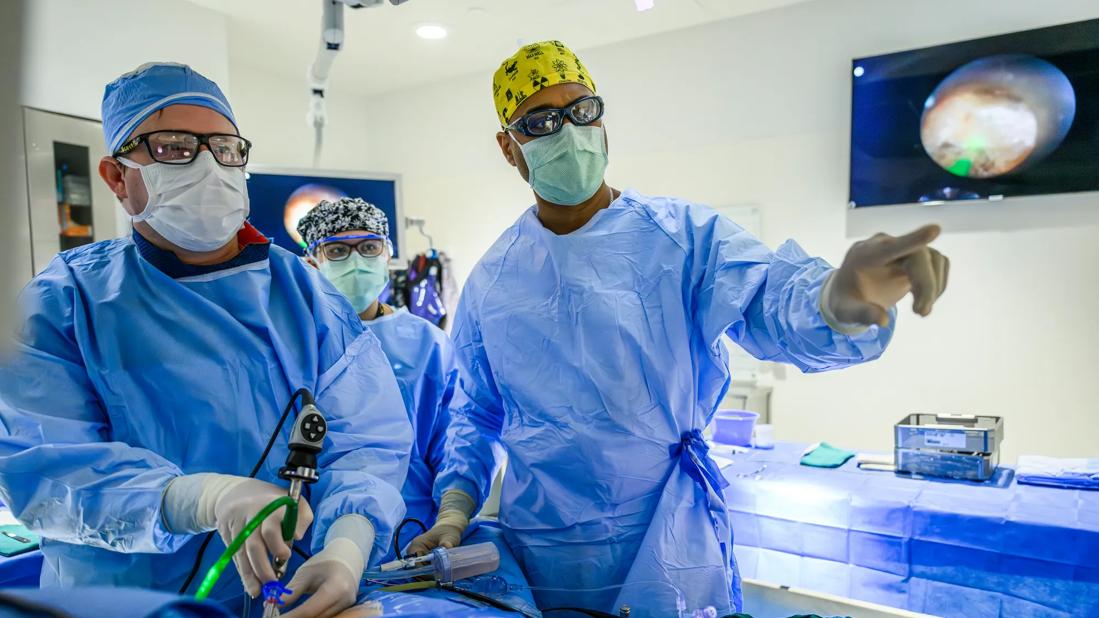Endourology patients using MyChart have fewer postoperative complications and unscheduled visits

Endourology practices, by nature, field an abundance of communication from patients with stone disease.
Advertisement
Cleveland Clinic is a non-profit academic medical center. Advertising on our site helps support our mission. We do not endorse non-Cleveland Clinic products or services. Policy
“We get many phone calls from patients needing attention for their acute pain,” says Sri Sivalingam, MD, Director of the Center for Endourology and Stone Disease at Cleveland Clinic Hillcrest Hospital. “Even after surgical treatment, up to 80% of patients have discomfort related to their ureteral stent. Some need pain medication while others just need reassurance. Either way, when they call and can’t talk to a caregiver right away, they often end up going to an emergency room or urgent care facility.”
Anecdotally, Dr. Sivalingam noticed that patients in his practice who were enrolled in Cleveland Clinic’s MyChart® electronic patient portal called the office less frequently and had fewer unscheduled provider encounters. To determine if there was a measurable clinical benefit for these patients, Dr. Sivalingam led a team of researchers from Cleveland Clinic’s Glickman Urological & Kidney Institute in reviewing the charts of patients who had endourology procedures at Hillcrest Hospital between July 2017 and July 2018.
Their findings, recently published in the Journal of Urology, indicate that use of an electronic patient portal may not only improve communication between patients and providers but also improve patient care and reduce complications of stone disease and its treatments.
Out of 313 patients in the study, 200 used MyChart and 113 didn’t. They had a total of 374 procedures, mostly kidney stone removal procedures such as ureteroscopy and percutaneous nephrolithotomy.
Patients who used MyChart were younger than nonusers (average age 56 vs. 61, P = 0.0011) and more likely to be married (69.5% vs. 48.7%, P = 0.0004). They also:
Advertisement
Patients who didn’t use MyChart were:
“Patients who embraced the MyChart portal really did exhibit improved outcomes through fewer visits and complications after their treatment,” says Dr. Sivalingam.
He attributes these improved outcomes to more direct communication with providers.
“Online patient portals can alleviate the need for patients to make a phone call, leave a message and wait for a return call from a provider,” says Dr. Sivalingam. “We respond to online messages in the patient portal as soon as we see them.”
There’s opportunity for any specialty provider to use online patient portals to improve efficiency and patient care, he adds, especially now that more patients are opting for virtual visits through online portals due to the COVID-19 pandemic.
“We all can encourage more patients to enroll in the online portals available to them,” says Dr. Sivalingam. “If one of my patients isn’t enrolled in MyChart, I ask my front desk or scheduling staff to enroll them before they leave their appointment.”
There are some hurdles, however. For example, how can providers engage older patients or patients with cognitive deficits in online portals? (Dr. Sivalingam often recruits a family member or other patient proxy to manage the portal account.) And, while patient portals may alleviate phone calls, how will practices manage the influx of online patient communication? (Dr. Sivalingam’s practice uses a graded triage system in which less complex messages are handled quickly by a pool of nurses, nurse practitioners and others, while more complex messages are flagged for a physician specialist.)
Advertisement
“The direct engagement between provider and patient can add clarity for patients concerned about their condition or next steps,” he says. “If a follow-up is needed, we address it right away. If it’s not needed, we can potentially prevent the patient from making an unnecessary visit.”
Advertisement
Advertisement

Digital “tripwires” detect and respond to malicious activity, boosting cybersecurity maturity

Effective provider training strategies incorporate multi-modal delivery

Thoughtful collaboration, data-driven decisions and effective change management lead to significant savings

A thoughtfully designed program to elevate participants’ leadership potential

Clinical input is integral to technology implementation and adoption strategy

Advancing technology makes informatics expertise essential

Integrating technology is more than product delivery

Combined expertise, collaboration and technology lead to several improvements